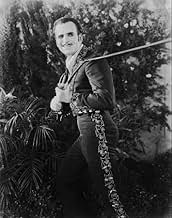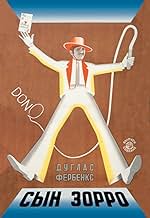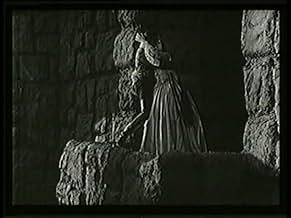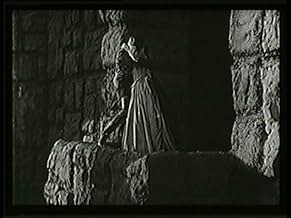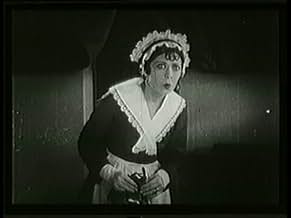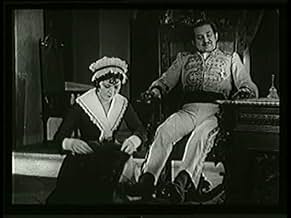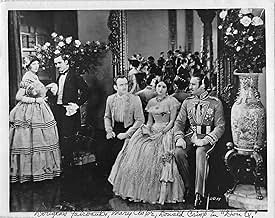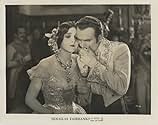Aggiungi una trama nella tua linguaDon Cesar, son of Zorro, is framed for murder while visiting Spain, and becomes the whip-wielding outlaw Don Q.Don Cesar, son of Zorro, is framed for murder while visiting Spain, and becomes the whip-wielding outlaw Don Q.Don Cesar, son of Zorro, is framed for murder while visiting Spain, and becomes the whip-wielding outlaw Don Q.
- Regia
- Sceneggiatura
- Star
- Premi
- 3 vittorie totali
Stella De Lanti
- Queen Isabella
- (as Stella DeLanti)
Lottie Pickford
- Lola
- (as Lottie Pickford Forrest)
George Blankman
- Undetermined Secondary Role
- (non citato nei titoli originali)
Charles Byer
- Undetermined Secondary Role
- (non citato nei titoli originali)
André Lanoy
- Artist
- (non citato nei titoli originali)
Recensioni in evidenza
Sprightly, only slightly less appealing sequel to Fairbank's first outing as Zorro. Here as Zorro's son, we also get some neat whiptricks and the sight of 2 Fairbanks (as Zorro and his son) in addition to the usual acrobatic stunts. The plot concerns Don Q being sent to the "old country" to study. He ends up framed for a crime by the corrupt officials of the Queen (who are made jealous when Don Q saves their commander from a bull with his whip, impressing the Queen with his courage). Zorro must come over to help him prove his innocence and defeat his enemies in battle.
As an early Zorro movie, well, an early movie period, this was fairly good. I will admit that some of it was kind of dumb. The plot is that Zorro's son has been framed for a murder. This happens because someone forges the murder victim's signature saying he was the killer. How could anyone be fooled into thinking someone wrote down who their murderer was? Was this a thing back in the 1920's? The Zorro costume does in fact appear, but unfortunately it's only in the last ten minutes. With all that being said, this still is by no means a bad movie. The original Zorro movie was better.
While this was before color, I really was impressed by the tints of this movie. I guess they don't count as colors, but this really was a nice looking movie. The atmosphere is probably the strongest point, because this is a movie that's very nice to look at with great sets. It's so nice to see how well they hold up after nearly a hundred years! I like the idea of Zorro having a son, but this was interesting because he wasn't just taking on the persona of Zorro. He really was becoming a new character in his own right. Sequels shouldn't just repeat what the original did. It's great to point out the flaws in such an old movie. While not a classic, it's fine. ***
While this was before color, I really was impressed by the tints of this movie. I guess they don't count as colors, but this really was a nice looking movie. The atmosphere is probably the strongest point, because this is a movie that's very nice to look at with great sets. It's so nice to see how well they hold up after nearly a hundred years! I like the idea of Zorro having a son, but this was interesting because he wasn't just taking on the persona of Zorro. He really was becoming a new character in his own right. Sequels shouldn't just repeat what the original did. It's great to point out the flaws in such an old movie. While not a classic, it's fine. ***
The rollout for a Douglas Fairbanks movie during the summer was becoming a much-heralded annual ritual for movie fans. During the steamy days of 1925, the actor/producer released his sequel to the highly successful 1920 "The Mark of Zorro" in July 1925's "Don Q, Son of Zorro." Cinematic special effects created a double of Fairbanks as he appears in the film's later scenes as an aging Don Diego Vega (Zorro) while his son (Fairbanks) is seen in the same frame.
The actor/producer combined the Hesketh-Prichard 1909 novel 'Don Q.'s Love Story' with the Zorro character. Don Q, Cesar, possessed as his main defensive weapon a whip, but was also adept with the sword. And he never wears a mask to hide his identity. The story's location in Spain allows "Don Q" to have a totally different cast of characters, including Cesar's arch love rival, Sebastian (Donald Crisp), head of the Queen's Palace Guard. Crisp, released previously by Buster Keaton for his handling of portions of 1924's "The Navigator," capably directed "Don Q." Crisp was no slouch when it came to directing, sitting in the monogrammed chair for some 70 films before he went full-time acting.
It was an interesting time for lead actress Mary Astor, who played the love interest between Fairbanks and Crisp as Dolores. Just 19 years old and only a three-year veteran of the screen, Astor was one of a number of very young actresses whose parents lived off her salary. After discouraging actor John Barrymore from marrying their daughter while making 1924's "Beau Brummel," Otto and Helen Langhanke (Mary's birth name was Lucile Langhanke before Paramount Pictures changed it) controlled every aspect of her life.
Just after filming "Don Q," Mary was closely kept to her parents' hips when they bought a Moorish-style mansion known as 'Moorcrest,' in the hills above Hollywood just below the recently built famous sign. Charlie Chaplin previously rented the 1921 house, right across the Theosophical Society's utopian community called Krotona. The Langhankes became friends with Marie Hotchener, a Theosophist. When Marie heard the parents were taking Mary's entire $2,500 a week salary to pay the mortgage and other luxury items, she convinced the Langhandes to give their daughter $5 per week as an allowance.
Soon tiring from her father's physical and psychological abuse, Mary climbed out of her bedroom window and sought refuge in a Hollywood hotel. Mrs. Hotchener again became the intermediary between the family and negotiated her return to the parents by forcing them to deposit $500 in her bank account. Mary also supposedly obtained control of her finances, which never happened until she was 26, four years after she had married director Kenneth Hawks, the brother of film director Howard Hawks.
The actor/producer combined the Hesketh-Prichard 1909 novel 'Don Q.'s Love Story' with the Zorro character. Don Q, Cesar, possessed as his main defensive weapon a whip, but was also adept with the sword. And he never wears a mask to hide his identity. The story's location in Spain allows "Don Q" to have a totally different cast of characters, including Cesar's arch love rival, Sebastian (Donald Crisp), head of the Queen's Palace Guard. Crisp, released previously by Buster Keaton for his handling of portions of 1924's "The Navigator," capably directed "Don Q." Crisp was no slouch when it came to directing, sitting in the monogrammed chair for some 70 films before he went full-time acting.
It was an interesting time for lead actress Mary Astor, who played the love interest between Fairbanks and Crisp as Dolores. Just 19 years old and only a three-year veteran of the screen, Astor was one of a number of very young actresses whose parents lived off her salary. After discouraging actor John Barrymore from marrying their daughter while making 1924's "Beau Brummel," Otto and Helen Langhanke (Mary's birth name was Lucile Langhanke before Paramount Pictures changed it) controlled every aspect of her life.
Just after filming "Don Q," Mary was closely kept to her parents' hips when they bought a Moorish-style mansion known as 'Moorcrest,' in the hills above Hollywood just below the recently built famous sign. Charlie Chaplin previously rented the 1921 house, right across the Theosophical Society's utopian community called Krotona. The Langhankes became friends with Marie Hotchener, a Theosophist. When Marie heard the parents were taking Mary's entire $2,500 a week salary to pay the mortgage and other luxury items, she convinced the Langhandes to give their daughter $5 per week as an allowance.
Soon tiring from her father's physical and psychological abuse, Mary climbed out of her bedroom window and sought refuge in a Hollywood hotel. Mrs. Hotchener again became the intermediary between the family and negotiated her return to the parents by forcing them to deposit $500 in her bank account. Mary also supposedly obtained control of her finances, which never happened until she was 26, four years after she had married director Kenneth Hawks, the brother of film director Howard Hawks.
Dashing Douglas Fairbanks (as Don Cesar de Vega) is the son of the legendary "Zorro", in this spectacular sequel to Mr. Fairbanks' own "The Mark of Zorro" (1920) *********. The younger Fairbanks has been sent to Spain, where he cracks his whip, and soaks up local color. There, he falls in love with pretty Mary Astor (as Dolores de Muro); watch out for the great introduction to Ms. Astor's character, as Fairbanks places wings on her silhouette. You know trouble is brewing when dastardly rival Donald Crisp (as Don Sebastian) is spurned by "belle of the Archduke's ball" Astor. In a fit of anger, Mr. Crisp assassinates Archduke Paul (as Warner Oland), and frames Fairbanks for the killing. Then, Fairbanks fakes his own suicide, and sets out to prove his innocence; eventually, he receives help from father "Zorro" (Fairbanks, in a dual role).
"Don Q, Son of Zorro" is a tremendous sequel, from Fairbanks and company, who wisely viewed follow-ups as a chance to equal, or improve upon, earlier hits. Not surprisingly, it lacks the spontaneity of the earlier film, and it is, perhaps, a little too long. However, the overall production is superior, and the storyline refreshingly unique; as "Don Q", and his story, are quite different than the original "Zorro". Crisp is very helpful, as both villain and director. And, Henry Sharp's photography is top notch.
The cast is terrific: alongside the aforementioned, you have Fairbanks regular Charles Stevens (as Robledo) in one of his more showy roles, otherwise humanitarian Jean Hersholt (as Don Fabrique) playing Crisp's blackmailing nemesis, famous sibling Lottie Pickford (as Lola), and Albert MacQuarrie (as Colonel Matsado) gets to ask Fairbanks: "Who the hell are you?"
"Don Q, Son of Zorro" is a tremendous sequel, from Fairbanks and company, who wisely viewed follow-ups as a chance to equal, or improve upon, earlier hits. Not surprisingly, it lacks the spontaneity of the earlier film, and it is, perhaps, a little too long. However, the overall production is superior, and the storyline refreshingly unique; as "Don Q", and his story, are quite different than the original "Zorro". Crisp is very helpful, as both villain and director. And, Henry Sharp's photography is top notch.
The cast is terrific: alongside the aforementioned, you have Fairbanks regular Charles Stevens (as Robledo) in one of his more showy roles, otherwise humanitarian Jean Hersholt (as Don Fabrique) playing Crisp's blackmailing nemesis, famous sibling Lottie Pickford (as Lola), and Albert MacQuarrie (as Colonel Matsado) gets to ask Fairbanks: "Who the hell are you?"
Like his father a generation before, a young Californian caballero must fight against treachery & evil in high places.
DON Q SON OF ZORRO was Douglas Fairbanks' rousing sequel to his previous hit film, THE MARK OF ZORRO (1920). Much more expansive & elaborate than the first film, Fairbanks shows what he's learned about producing silent swashbucklers in the intervening five years. Mixing history, spectacle & lots of action, Doug always gave his audience their money's worth.
By this point in his career, Fairbanks was the absolute master of the swashbuckler. Whether romancing a fair señorita, fighting off hordes of enemy swordsmen, or jumping all about the architecture, his infectious grin & superb athletic prowess never fail to charm the viewer. And here he gets to charm twice, playing both father & son very nicely.
Doug is given wonderful support from three excellent character actors: Warner Oland as a silly Austrian Archduke whose foolish behavior precipitates the movie's crisis; Jean Hersholt as a social climbing buffoon who gets more than he bargained for; and vile Donald Crisp (who also directed) as the villain who wants both Fairbanks' life & sweetheart.
Although given little to do, Mary Astor is still a lovely heroine worth the fighting of several duels.
But this remains Fairbanks' film. His powerful personality & spectacular stunts not only dominate the movie, but also have ensured him an unassailable niche in Hollywood history.
DON Q SON OF ZORRO was Douglas Fairbanks' rousing sequel to his previous hit film, THE MARK OF ZORRO (1920). Much more expansive & elaborate than the first film, Fairbanks shows what he's learned about producing silent swashbucklers in the intervening five years. Mixing history, spectacle & lots of action, Doug always gave his audience their money's worth.
By this point in his career, Fairbanks was the absolute master of the swashbuckler. Whether romancing a fair señorita, fighting off hordes of enemy swordsmen, or jumping all about the architecture, his infectious grin & superb athletic prowess never fail to charm the viewer. And here he gets to charm twice, playing both father & son very nicely.
Doug is given wonderful support from three excellent character actors: Warner Oland as a silly Austrian Archduke whose foolish behavior precipitates the movie's crisis; Jean Hersholt as a social climbing buffoon who gets more than he bargained for; and vile Donald Crisp (who also directed) as the villain who wants both Fairbanks' life & sweetheart.
Although given little to do, Mary Astor is still a lovely heroine worth the fighting of several duels.
But this remains Fairbanks' film. His powerful personality & spectacular stunts not only dominate the movie, but also have ensured him an unassailable niche in Hollywood history.
Lo sapevi?
- QuizDanish composer Jacob Gade's internationally famous piece "Tango Jalousi" was composed for the Danish gala premiere of this film, which took place 14 September 1925 in Palads Teatret, Copenhagen.
- Citazioni
Don Cesar de Vega: My father always said, "When you are in the right, fight; when you are in the wrong, acknowledge it."
- ConnessioniFeatured in Sprockets: Cliffhangers (1995)
I più visti
Accedi per valutare e creare un elenco di titoli salvati per ottenere consigli personalizzati
Dettagli
- Tempo di esecuzione1 ora 51 minuti
- Mix di suoni
- Proporzioni
- 1.33 : 1
Contribuisci a questa pagina
Suggerisci una modifica o aggiungi i contenuti mancanti

Divario superiore
By what name was Don Q Son of Zorro (1925) officially released in Canada in English?
Rispondi

